

We May Have Figured Out How the Brain Processes Experiences. In Brief We associate positive feelings with foods and experiences we enjoy, and negative feelings with the opposite.
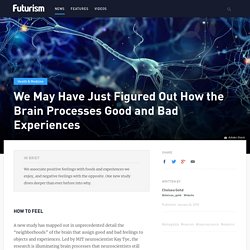
One new study dives deeper than ever before into why. How to Feel A new study has mapped out in unprecedented detail the “neighborhoods” of the brain that assign good and bad feelings to objects and experiences. Led by MIT neuroscientist Kay Tye, the research is illuminating brain processes that neuroscientists still don’t understand, and could have implications for treating mental health disorders. In 2016, Tye’s research team found that within the amygdala — the center for emotions in the brain — there are neurons that assign good or bad feelings known as “valence.” The team, led by lead author Anna Beyeler, trained mice to associate “good” tasting sucrose drops with a certain audible tone, and bitter quinine drops with a different tone.
Understanding Valence At the end of the experiment, the team had mapped over 1,600 neurons. Brain Implants Will Drive Our Evolution and “Extend Our Capabilities” Evolution Isn’t Over It took billions of years for homo sapiens to emerge, but that’s not the end of our story — humans, scientists agree, continue to evolve.
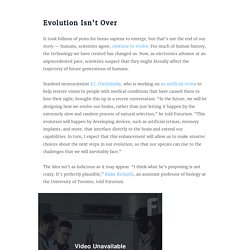
For much of human history, the technology we have created has changed us. Now, as electronics advance at an unprecedented pace, scientists suspect that they might literally affect the trajectory of future generations of humans. Stanford neuroscientist E.J. Chichilnisky, who is working on an artificial retina to help restore vision to people with medical conditions that have caused them to lose their sight, brought this up in a recent conversation. The idea isn’t as ludicrous as it may appear. DARPA's New Brain Device Increases Learning Speed by 40% In Brief An international team of scientists has created a non-invasive device that stimulates the brain to improve cognitive function.
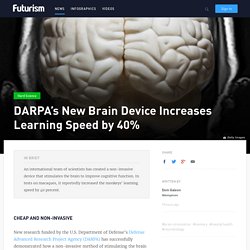
In tests on macaques, it reportedly increased the monkeys' learning speed by 40 percent. Cheap and Non-Invasive New research funded by the U.S. We can restore cognition by manipulating where the body meets the mind. When we age our whole body gradually deteriorates.
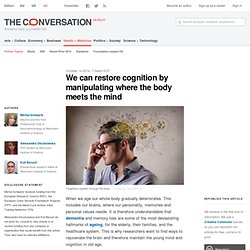
This includes our brains, where our personality, memories and personal values reside. It is therefore understandable that dementia and memory loss are some of the most devastating hallmarks of ageing, for the elderly, their families, and the healthcare system. Here's What Elon Musk Thinks About Brain Implants, AI, And Basic Income. In Brief At today's World Government Summit in Dubai, Elon Musk stated that Universal Basic Income may be the only solution to automation and job loss, brain implants will be needed to help humans stay on top of artificial intelligences, and that Tesla is going to have some major breakthroughs in 2017.

The Governments of the Future Every year since 2013, the world’s most powerful leaders and forward-thinking innovators have gathered in the city of Dubai in the United Arab Emirates for the World Government Summit, an event dedicated to helping mold the governments of the future. Attendees work together to identify potential problems and then determine ways that today’s technology can be used to alleviate those challenges.
Past events have featured such speakers as U.S. Elon Musk: If Humans Are to Survive, We Must Merge With Machines. In Brief Elon Musk thinks that, as AI technology and automation continue to replace jobs and more traditional technology, humans will become obsolete and need to merge with machinesSince computers can communicate at speeds well beyond an organic organisms' capacity, Musk thinks that creating a symbiotic relationship between us and our tech will give us the edge we need.
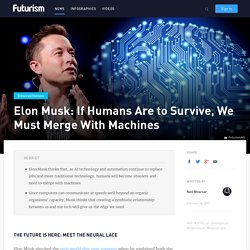
A New Device Could Make Memory Implants a Reality. Total Recall Memories are the faintest, most ethereal wisps of our neurophysiology — somehow, the firing of delicate synapses and the activation of neurons combine to produce the things we remember.
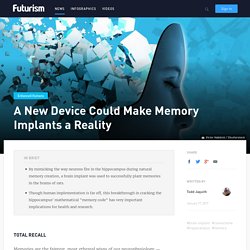
The sum of our memories make us who we are; they are us, in every way, and without them we cease to be. Becoming Immortal: The Future of Brain Augmentation and Uploaded Consciousness. If you’ve ever worked with a virtualized computer, or played a video game ROM from a long-defunct console on your new PC, you understand the concept already: a mind is simply software, and the brain, the hardware it runs on.
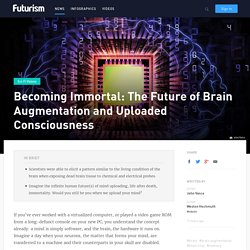
Imagine a day when your neurons, the matter that forms your mind, are transferred to a machine and their counterparts in your skull are disabled. Are you still you? Imagine a future of mind uploading, whole-brain emulation, and the full understanding of the connectome. Now, imagine neuroscientists even discover a way to resurrect the dead, to upload the mind of those who have gone before, our ancestors, Socrates, Einstein? In a paper published in Plos One in early December, scientists detailed how they were able to elicit a pattern similar to the living condition of the brain when exposing dead brain tissue to chemical and electrical probes. This was inferred by a reliable modulation of frequency-dependent microvolt fluctuations. Scientists Successfully Decode Thoughts, Reading Individuals' Minds in Real-Time. Mind-reading is often dismissed as nothing more than a charlatan trick, but scientists and researchers are trying to change this ‘decoding of the brain’ from quack-science to hard science.
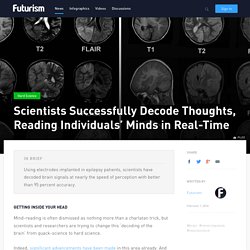
Indeed, significant advancements have been made in this area already. And now, University of Washington scientists have developed technology that allows a device to effectively read your mind. With a combination of brain implants and sophisticated software, the team was able to interpret their subjects’ thoughts and extrapolate what their subjects were seeing. Thanks to this study, scientists were able to gain insight into how people are able to translate sensory information from an image into something our minds can comprehend. In their work, which was published in PLOS Computational Biology, the researchers implanted electrodes for a week in seven epilepsy patients. Direct brain-to-brain connection transmits signals over the internet. In Brief These researchers have found a way to transmit brain signals from one person to another in order to guess the correct answers to a set of given questions.
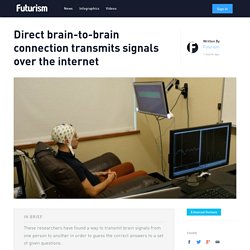
The Breakthrough Researchers at the University of Washington have experimented with a brain-to-brain connection which allowed pairs of participants to transmit answers to questions from one person to the other using their brain signals and the Internet. This experiment was done in darkened rooms within two of the university’s labs that are located a mile apart and involved five pairs that played 20 rounds of the question-and-answer game. Bridging the Bio-Electronic Divide: How We're Translating Brain Activity Into Binary. DARPA (the Defense Advanced Research Projects Agency) announced last Tuesday that it plans to build a chip that would allow the human brain to communicate directly with computers. Our minds would essentially be speaking in binary. At least, that’s the ultimate goal. US Scientists Developing Brain Implants That Can Connect Human Brain to Digital World.
In Brief A human brain that speaks in binary? It could be a reality. DARPA is looking into creating an interface that can connect the human brain and modern technology seamlessly. Wearable tech can be implanted in brains, thanks to new power technique. A breakthrough in wireless technology could allow a new wave of health tracking tools that can be embedded inside our bodies – in our livers, hearts and even in our brains. A new wireless charging technique known as “mid-field wireless transfer” can deliver power to tiny electronic devices such as sensors, pacemakers and nerve stimulators embedded deep within the body. They can be charged using a device the size of a credit card placed outside the body. "With this method, we can safely transmit power to tiny implants in organs like the heart or brain, well beyond the range of current near-field systems,” said Dr John Ho, co-author of the study that appears in the Proceedings of the National Academy of Sciences.
‘Make these devices as small as possible’ Ray Kurzweil: In The 2030s, Nanobots In Our Brains Will Make Us 'Godlike' New Research Shows Uniqueness of the Human Brain. Researchers have debunked many of the (previously) well-established beliefs related to how the human brain is “special.” For example, neuroscientist Suzana Herculano-Houzel found that the number of neurons relative to the human brain size is consistent with other primates. She also found that the cerebral cortex, which is responsible for cognitive learning, isn’t uniquely large. Indeed, it holds around 20 percent of all our brain’s neurons, and we see similar proportions in other mammals. The research doesn’t stop there, either.
Other scientists have found that traits believed to be unique to humans also exist in other members of the animal kingdom. So ultimately, the idea that our brains are “special” has been thoroughly debunked; however, as is true of all species, there are many ways in which we are different from the rest of the animal kingdom. Humans are similar to other animals on the genetic level. Cyberware. Cyberware is a relatively new and unknown field (a proto-science, or more adequately a “proto-technology”). In science fiction circles, however, it is commonly known to mean the hardware or machine parts implanted in the human body and acting as an interface between the central nervous system and the computers or machinery connected to it. More formally: How Brain-Computer Interfaces Work. How Brain-Computer Interface Works.
The Brain-Computer Interface System. Configuration of Internal & External Braingate. Integrating Brain Tissue & Microchip. Brain Implant Configuration. Biocompatible interfaces replace silicon and metal in neural prosthetic devices. Left: collagen; right: matrigel (credit: Wen Shen et al. /Microsystems & Nanoengineering) Researchers at the University of Georgia’s Regenerative Bioscience Center have developed a biocompatible implantable neural prosthetic device to replace silicon and noble metal in neural prosthetic devices.
The goal is to avoid immune-system rejection, failures due to tissue strain, neurodegeneration, and decreased fidelity of recorded neural signals. Implantable neural prosthetic devices in the brain have been around for almost two decades, helping people living with limb loss and spinal cord injury become more independent, for example. Injectable electronics holds promise for basic neuroscience, treatment of neuro-degenerative diseases. It's a notion that might be pulled from the pages of science-fiction novel - electronic devices that can be injected directly into the brain, or other body parts, and treat everything from neurodegenerative disorders to paralysis. Neuromodulation 2.0: New Developments in Brain Implants, Super Soldiers and the Treatment of Chronic Disease.
Neuromodulation 2.0: New Developments in Brain Implants, Super Soldiers and the Treatment of Chronic Disease. 10 Brain Implant Superpowers. A new era of cognitive computing. IBM says it is possible to build a new computing architecture that is more human-like and biologically inspired than traditional systems. After a year of “medical school”, IBM’s intelligent supercomputer, Watson, has produced its first commercially available applications for doctors and health insurance companies. Now that Watson is proving itself in the medical field, the door is being flung open for other industries and a new era of cognitive computing.
A paralyzed woman flies a fighter jet with her mind. Back in February of 2012, a paralyzed 55 year old mother Mrs. With Mindware Upgrades and Cognitive Prosthetics, Humans Are Already Technological Animals. In recent years, the surprising idea that we’ll one day merge with our technology has warily made its way into the mainstream. Implant corrects brain errors. Sensor chip for implanting into a brain. Size of Microchip Brain Implant. Brain-Computer Electrode Array. Brain Implant. Brain-Computer Array Implanted in Brain. Surgical Implants of Nanowire in Brain. Wearable scanner opens new frontier in neuroscience. Scientists Develop A Way To Visualise The Brain In Real-Time. What if you could watch your brain and see exactly what you were thinking? The Future of Brain Implants. Resulting Utility of Brain Implants. Flexible Brain Implants Have Arrived. Researchers develop brain implant for improving memory. Brain implants: Restoring memory with a microchip.
First Human Tests of Memory Boosting Brain Implant—a Big Leap Forward. Scientists 'reactivate' Alzheimer's patients' memories. Consciousness in Mixed Artificial & Biological Brains. Scientists Selectively Erase And Restore Memories. Brain implants: Restoring memory with a microchip. New Chip Allows Memory & Behavior to Transfer From One Brain To Another. DARPA Aims to Improve Memory Skills. Pentagon Rolls Out DARPA Plan To Implant Chips In Soldiers. Mind Uploading = Brain Emulation = Reverse Engineering the Brain. Mind Uploading: Brain Facts. Hawking predicts uploading the brain into a computer. If You Upload Your Mind to a Computer—Are You Still You? Will You Live Forever—or until Your Next Software Release—by Uploading Your Brain into a Computer?
How to Live Forever By Turning Your Brain Into Plastic. How Much Longer Until Humanity Becomes A Hive Mind? Scientists Found a Way to Email Brain Waves. Direct Brain-to-Brain Communication Demonstrated Over The Internet. Scientists Prove That Telepathic Communication Is Within Reach. Researcher Remotely Operates Colleague’s Brain Over The Internet. New Device Makes It Possible to Take Pictures With Your Mind. Intelligence amplification. Nootropic. Exocortex. Singularity Surplus: Put on Your Electric Thinking Cap! The Future of Intelligence. Humans With Amplified Intelligence Could Be More Powerful Than AI_ "Smart Drug" Modafinil Is Safe and Effective, Harvard and Oxford Researchers Find.
Growing brains in the lab. Bioengineers create functional 3-D brain-like tissue. Scientists Create Functional 3D Brain Tissue. Functional 3D Brain Tissue Successfully Grown From Stem Cells. The Brain: The Connections May Be the Key. Master protein found to enhance both muscles and the brain. Protein Pairing Builds Brain Networks. First-Ever Incredible Footage of a Thought Being Formed. The Feel-Good Switch: The Radical Future of Emotion. Artificial Neurons Can Communicate in the Same Way as Human Neurons. Swedish scientists create an artificial neuron that mimicks an organic one. Replacement & Regeneration of Damaged Neural Circuitry. A Cybernetic Implant That Repairs Brain Damage. Aging of Brain and Muscles Reversed Through Protein Therapy. Scientists Manipulate Genes to Make Old Organs Young Again (in Mice)
Stem cells show promise for stroke in pilot study. DARPA Program Seeks to Use Brain Implants to Control Mental Illness. The Feel-Good Switch: The Radical Future of Emotion.